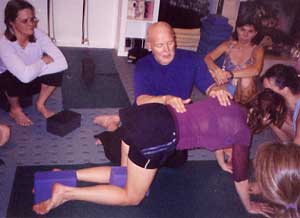A primary principle of hatha yoga is: Where awareness goes, energy flows, and energy flows where awareness goes. Historically, what has made hatha yoga unique is its emphasis on the active practice of asana and pranayama as the foundation upon which the other six limbs of yoga are actualized. What distinguishes yoga as a spiritual practice is the practitioner’s commitment to seeing his or her thoughts, behaviors and self clearly. Patanjali’s Yoga Sutras makes the point that a primary outcome of yoga is that we de-condition ourselves from our socialization.
While it is true that asanas and pranayama lead naturally to seated meditation, the ancient yoga masters realized two things: Meditation is more profound when the energy field is balanced and the core of our physical being is strong and stable. And the energy field is in constant fluctuation between balanced, healthy patterns and imbalanced, unhealthy patterns. In the hatha yoga tradition the practice of asana and pranayama is meant not only to stimulate and balance the energy that flows in the meridian channels but also to be a meditation, where self-awareness can occur.
It is the yoga teacher’s role to create an atmosphere in which a meditative approach can grow out of the yoga practice. The emphasis of teaching can be on students’ increasing capacity to expand their awareness and hence balance their energy field. Correspondingly, less emphasis is placed on performing demanding sequences and advanced asanas. Students eventually become aware that the capacity to achieve the more demanding shapes and movements of the asanas is determined by constitutional factors (vata, pitta and kapha, the three doshas, or body types, of the ayurvedic system), astrology, karma, genetics and their history of physical movement and trauma.
 For those yoga students with a strong and balanced energy field, asanas are an excellent means to develop and maintain a strong and stable core. Unfortunately, however, by the time most people come to practice yoga, their energy field is unbalanced and their core strength and stability are compromised. In most yoga classes vast individual differences in movement capacity can be seen. As soon as the first general direction is given and the students respond, everyone looks different. The more demanding the asana, the greater the expressed differences. These differences are not due to a communication problem but rather are expressions of basic individual variation rooted in the above-mentioned constitutional factors and differences in core strength and stability, which affect suppleness.These differences require individually designed solutions and cannot be resolved by more explanation, demonstrations or being admonished to practice longer and harder. In order to guide students to uncover and then transform deeply ingrained imbalances while practicing asana and pranayama, the teacher must offer accessible ways to correct the imbalance and weaknesses that are discovered. Unless students have highly refined awareness and kinetic sense, it is very difficult for them to perceive their own neuromuscular and skeletal imbalances.
For those yoga students with a strong and balanced energy field, asanas are an excellent means to develop and maintain a strong and stable core. Unfortunately, however, by the time most people come to practice yoga, their energy field is unbalanced and their core strength and stability are compromised. In most yoga classes vast individual differences in movement capacity can be seen. As soon as the first general direction is given and the students respond, everyone looks different. The more demanding the asana, the greater the expressed differences. These differences are not due to a communication problem but rather are expressions of basic individual variation rooted in the above-mentioned constitutional factors and differences in core strength and stability, which affect suppleness.These differences require individually designed solutions and cannot be resolved by more explanation, demonstrations or being admonished to practice longer and harder. In order to guide students to uncover and then transform deeply ingrained imbalances while practicing asana and pranayama, the teacher must offer accessible ways to correct the imbalance and weaknesses that are discovered. Unless students have highly refined awareness and kinetic sense, it is very difficult for them to perceive their own neuromuscular and skeletal imbalances.
Moreover, if the purpose of asana practice is balancing the energy field, then there is an inherent contradiction in practicing unbalanced movement patterns. Practicing asana in a balanced way will often produce an asana of nonstandard shape, but the results of such yoga practice will lead the student towards balance and freedom of movement. A healthy, balanced pattern of energy flow supports the proper working of the neuromuscular system and adjusts skeletal alignment.Since many students who come to yoga already have developed imbalances, the aim of achieving asanas with an idealized final shape becomes questionable. Consider the asana downward-facing dog, in which there is often emphasis put on bringing the heels to the floor. As the yoga student brings his or her heels to the floor, the tendency is to extend the foot by leading with the inside of the heels. This both reflects imbalance and produces even more problems in energy channels, leading to further muscle de-stimulation. To continually practice in this way leads to practice-induced chronic injuries, which are becoming all too common.
The solution to this dilemma is for yoga instructors to see each asana in terms of the basic movements that are required to produce its shape and to understand what each student brings to the asana—his or her movement capacity, core strength and stability, flexibility and any adaptive and/or imbalance patterns.In the “High Energy Yoga” workshops I teach with Kari Tomashik, the students flow through an asana sequence that stimulates healthy energy flow and enables them an opportunity to observe their own movement patterns. The students also practice transformational work in pairs, giving each other hands-on feedback about the internal actions in designated asanas. The partner first gives verbal feedback, which stimulates thinking about the pose, then tactile feedback, which draws the awareness of the student doing the pose to the part of the body that is being touched. The energy field of the practitioner is “read” by the partner when he or she discerns unevenness in the energy of the inner actions. The unevenness in movement alerts us to energy field imbalances, which indicate underlying problems in the neuromuscular system. This unevenness will create problems in posture and movement until the energetic imbalance is changed. The teacher must individualize directions to help yoga students discover their own imbalances and then learn how to bring about balance in their energy body.The transformational work’s emphasis is on receiving tactile feedback from the partner in order to produce equal action in the basic inner dynamics of the asanas. It is often necessary to add resistance to these asanas in order to build strength to overcome core instability and weakness. As students become astute in both giving feedback and working with their own strengths and weaknesses, the transformational work will strengthen the core, align bones of the skeleton and create suppleness in the muscles.
Prone mountain pose can serve as an example of how students can be assisted in transformational work to help them understand the inner dynamic of this asana.The students lie face down on a yoga mat with eyes looking straight down and nose slightly off the mat. The hands are placed under the shoulders, as in cobra. The shoulders are slightly lifted off the floor. Keeping the shoulders lifted upward, the hands are then extended alongside the torso and kept off the floor. The legs are extended back with toes pointed and a block is placed between the feet, with the inner balls of the feet and inner heels touching the block. The thighs and knees are completely in contact with the floor while the shins’ distance from the floor will vary. The shins are positioned to minimize compromising the integrity of the heel and arch.While being facilitated by the touch of the partner, the student doing the pose is directed to carry out the following actions. All of the actions should occur evenly and at the same time. The action of the lower shin bones near the ankle is towards the midline of the body, while the action of the back side of the shin just above the ankle is upward. The thigh bone action just above the knee is towards the outside of the body, while the action alongside the front of the thigh is downward. The partner’s hands are placed alternately at the shins and then the thighs to draw awareness to these areas and facilitate internal movement. If unevenness in movement is felt, the partner instructs the student to press more where there is less energy. The action and resistance across the joints at the shins and thighs stimulate the muscles of the lower core, including those of the lower gluteus, upper leg and inner pelvis.
The lower arm bone resists downward, creating an upward resistance in the upper arm. The partner’s hands are placed on the upper arm so the student in the pose can resist upward into the hands; this gives feedback to the lower arm so resistance downward can occur. The partner must move his or her hands between these areas in order to determine evenness of effort and direct the student’s energy and awareness to these areas.While the yoga student is in prone mountain, the curves of the spine are often accentuated. The partner encourages the student in the pose to balance the resistance of the inner actions of the leg and arm bones to correct the spinal curves. The resistance of the limbs stimulates the muscles of the core that are understimulated and allows the overstimulated muscles to relax. And it is here that energy trapped in the muscles is freed, so energy flows unobstructed.Yoga taught with this kind of direct feedback in the transformational asanas gives students an opportunity to discover both their strengths and weaknesses, understand constitutional movement patterns and learn to work with them in a positive and patient way.Students also learn how they can work more effectively in the asanas during the sequence. They come to appreciate that advancement is not about achieving the more demanding and complex shapes and movements of the asanas. They now see progress as the refinement of their ability to discern the inner dynamics of resistance and action and transform unbalanced patterns of posture and movement while also observing the effects of asana practice in standing, sitting, moving, pranayama, meditation and life.
 For those yoga students with a strong and balanced energy field, asanas are an excellent means to develop and maintain a strong and stable core. Unfortunately, however, by the time most people come to practice yoga, their energy field is unbalanced and their core strength and stability are compromised. In most yoga classes vast individual differences in movement capacity can be seen. As soon as the first general direction is given and the students respond, everyone looks different. The more demanding the asana, the greater the expressed differences. These differences are not due to a communication problem but rather are expressions of basic individual variation rooted in the above-mentioned constitutional factors and differences in core strength and stability, which affect suppleness.These differences require individually designed solutions and cannot be resolved by more explanation, demonstrations or being admonished to practice longer and harder. In order to guide students to uncover and then transform deeply ingrained imbalances while practicing asana and pranayama, the teacher must offer accessible ways to correct the imbalance and weaknesses that are discovered. Unless students have highly refined awareness and kinetic sense, it is very difficult for them to perceive their own neuromuscular and skeletal imbalances.
For those yoga students with a strong and balanced energy field, asanas are an excellent means to develop and maintain a strong and stable core. Unfortunately, however, by the time most people come to practice yoga, their energy field is unbalanced and their core strength and stability are compromised. In most yoga classes vast individual differences in movement capacity can be seen. As soon as the first general direction is given and the students respond, everyone looks different. The more demanding the asana, the greater the expressed differences. These differences are not due to a communication problem but rather are expressions of basic individual variation rooted in the above-mentioned constitutional factors and differences in core strength and stability, which affect suppleness.These differences require individually designed solutions and cannot be resolved by more explanation, demonstrations or being admonished to practice longer and harder. In order to guide students to uncover and then transform deeply ingrained imbalances while practicing asana and pranayama, the teacher must offer accessible ways to correct the imbalance and weaknesses that are discovered. Unless students have highly refined awareness and kinetic sense, it is very difficult for them to perceive their own neuromuscular and skeletal imbalances.









